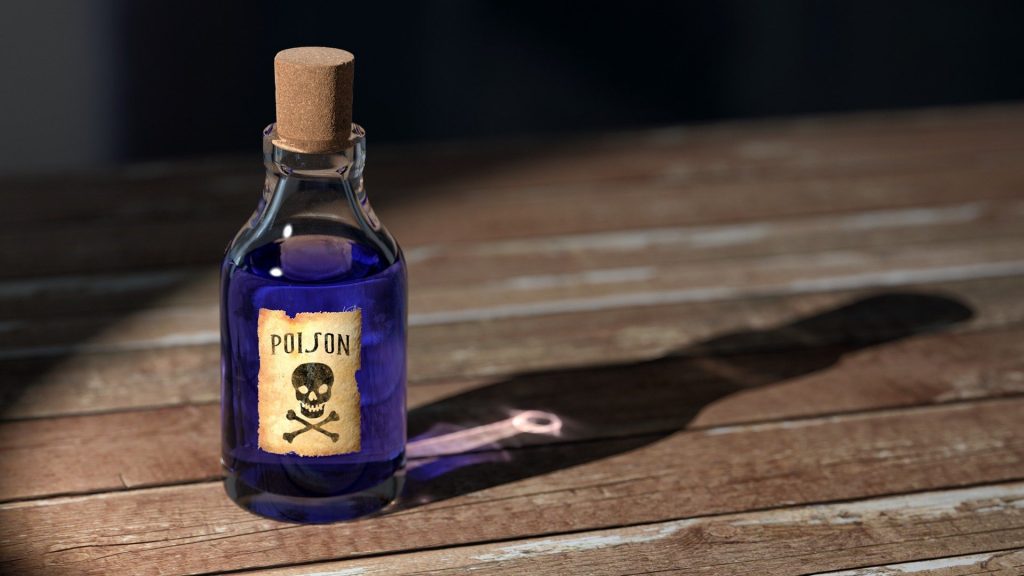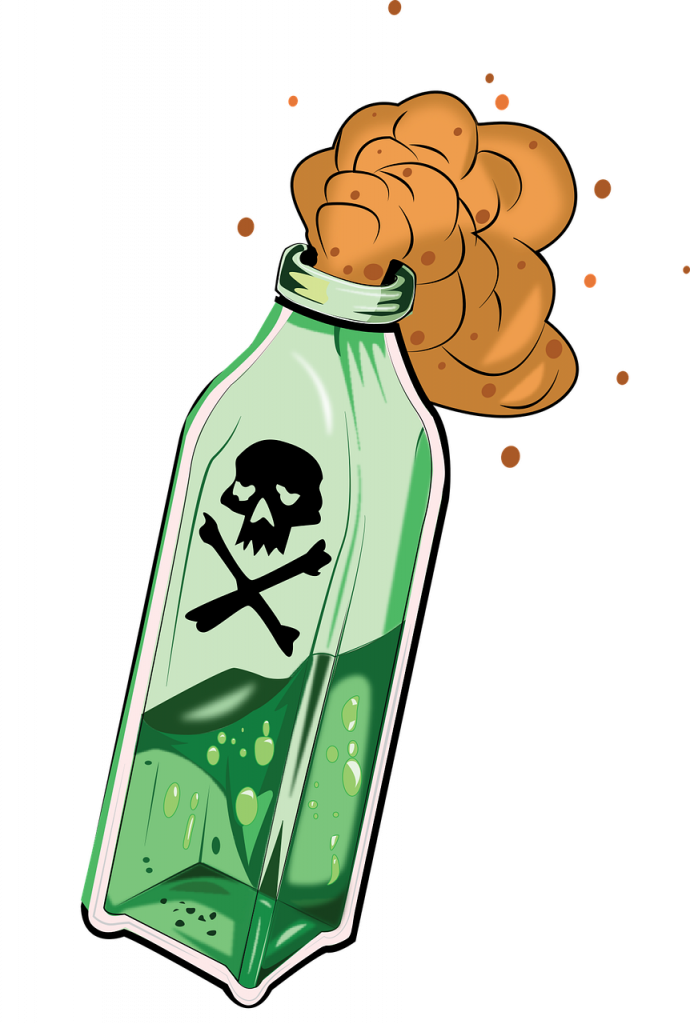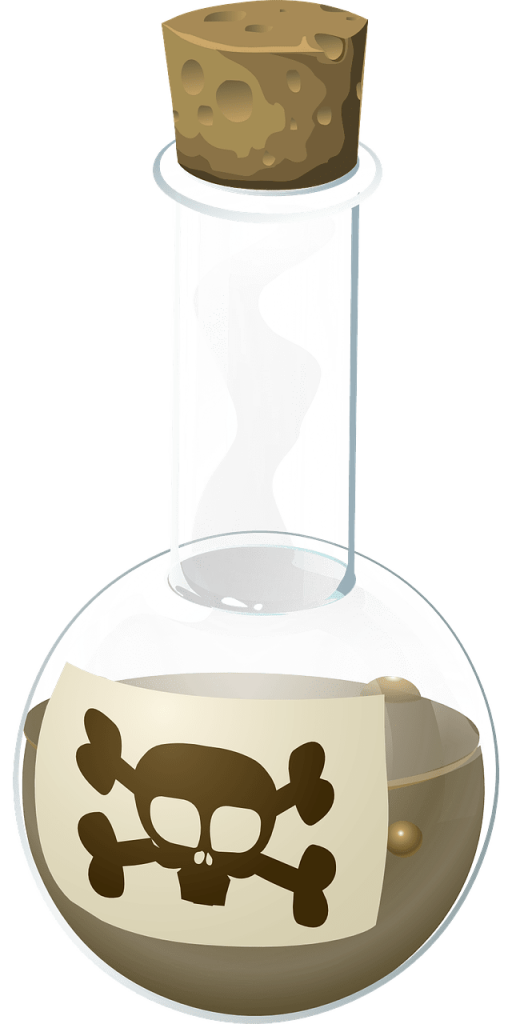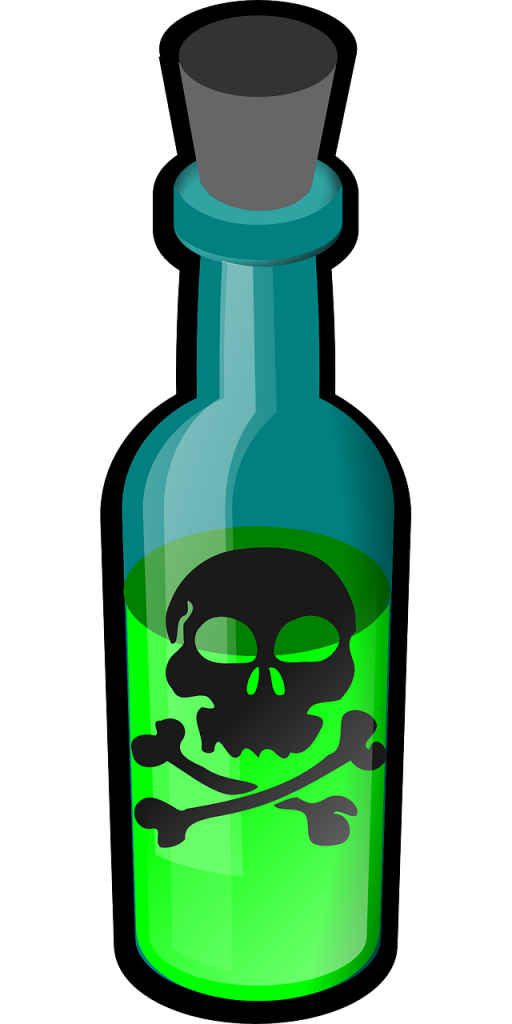Poison:
Table of Contents
In biology, poisons are substances that cause disturbances in organisms, usually by chemical reaction or other activity on the molecular scale, when an organism absorbs a sufficient quantity.
The fields of medicine (particularly veterinary) and zoology often distinguish a poison from a toxin and a venom. Toxins are poisons produced by organisms in nature, and venoms are toxins injected by a bite or sting (this is exclusive to animals). The difference between venom and other poisons is the delivery method. Industry, agriculture, and other sectors use poisons for reasons other than their toxicity. Pesticides are one group of substances whose toxicity to various insects and other animals deemed to be pests (e.g., rats and cockroaches) is their prime purpose.

In 2013, 3.3 million cases of unintentional poisonings occurred. This resulted in 98,000 deaths worldwide, down from 120,000 deaths in 1990.

Types of Poisoning:
Acute poisoning is exposure to a poison on one occasion or during a short period. Symptoms develop in close relation to the exposure. The absorption of a poison is necessary for systemic poisoning. In contrast, substances that destroy tissue but do not absorb, such as lye, are classified as corrosives rather than poisons. Furthermore, many common household medications are not labeled with skull and crossbones, although they can cause severe illness or even death. In the medical sense, poisoning can be caused by less dangerous substances than those legally classified as poison.
Chronic poisoning is long-term repeated or continuous exposure to a poison where symptoms do not occur immediately or after each exposure. The patient gradually becomes ill or becomes ill after a long latent period. Chronic poisoning most commonly occurs following exposure to poisons that bioaccumulate, or are biomagnified, such as mercury, gadolinium, and lead.
Contact or absorption of poisons can cause rapid death or impairment. Agents that act on the nervous system can paralyze in seconds or less, and include both biologically derived neurotoxins and so-called nerve gases, which may be synthesized for warfare or industry.
Inhaled or ingested cyanide, used as a method of execution in gas chambers, almost instantly starves the body of energy by inhibiting the enzymes in mitochondria that make ATP. Intravenous injection of an unnaturally high concentration of potassium chloride, such as in the execution of prisoners in parts of the United States, quickly stops the heart by eliminating the cell potential necessary for muscle contraction.
Most biocides, including pesticides, are created to act as poisons to target organisms, although acute or less observable chronic poisoning can also occur in non-target organisms (secondary poisoning), including the humans who apply the biocides and other beneficial organisms. For example, the herbicide 2,4-D imitates the action of a plant hormone, which makes its lethal toxicity specific to plants. Indeed, 2,4-D is not a poison but classified as “harmful” (EU).
Many substances regarded as poisons are toxic only indirectly, by toxication. An example is “wood alcohol” or methanol, which is not poisonous itself but is chemically converted to toxic formaldehyde and formic acid in the liver. Many drug molecules are made toxic in the liver, and the genetic variability of certain liver enzymes makes the toxicity of many compounds differ between individuals.
Exposure to radioactive substances can produce radiation poisoning, an unrelated phenomenon.

Antidotes:
Antidotes are the agents which are used to reverse stop or counteract the action of poisons. Cyanide produces a rapid onset of toxicity which must be vigorously and immediately treated to prevent the toxic syndrome. To obtain better protection, a series of newer antidotes either alone or in adjunction with the conventional treatments have been examined.
Based on their mechanism of action, antidotes can be classified as follows:
Physiological antidote:
It acts by producing the effect opposite to that produced by the poison which means to counteract the effect of poison physiologically.
Example: Sodium nitrite is used to treat cyanide poisoning.
Chemical antidote:
It acts by combining with the poison and thus, changes the chemical nature such that the poison cannot act anymore.
Example: Sodium thiosulphate is used to treat cyanide poisoning.
Mechanical antidote:
It acts by preventing the absorption of poison in the body or expelling out the poison by elimination through urine or emesis.
Example: Activated charcoal.

Cyanide Poisoning:
It normally occurs when taken internally for suicidal purposes or accidentally. Cyanide ion combined with the ferric ion of cytochrome oxidase as the enzyme is responsible for electron transfer reaction. This leads to the stoppage of cellular respiration and metabolic reactions immediately.
In cyanide poisoning, sodium nitrite and sodium thiosulphate injection are given to counteract the effect of the cyanide poison.
Sodium thiosulphate reacts with cyanide ion and converts into sodium thiocyanide which is less toxic than cyanide. While sodium nitrite reacts with ferrous iron and hemoglobin and convert into ferric iron of methemoglobin and thus reduces the concentration of cyanide ion.
Sodium Thiosulphate:
Molecular formula: Na₂S₂O3, 5H₂O, Molecular weight: 248.2
Sodium thiosulphate contains not less than 99.0 percent and not more than 101.0 percent of Na₂S₂O3, 5H₂O.
Properties:
Colorless large crystals or a coarse, crystalline powder; odorless; deliquescent in moist air and effloresces in dry air at a temperature above 33°. It dissolves in its water of crystallization at about 49° C.
Preparation:
It can be prepared by boiling sodium sulfite with sulfur.
Na₂SO3 + S → Na₂S₂O3
Assay:
Weigh accurately about 0.5 g, dissolved in 20 ml of water, and titrate with 0.05 M iodine using starch solution, added towards the end of the titration, as an indicator. 1 ml of 0.05 M iodine is equivalent to 0.02482 g of Na₂S₂O3.5H₂O.
Storage:
Store in a clean and dry place, protected from moisture.
Uses:
1. It has been included in pharmacopeia as an antidote for cyanide poisoning.
2. For this purpose a 10% w/v solution is used intravenously although a 2.98% w/v solution is isotonic with serum.
3. Sodium thiosulphate is also a very important reducing agent and is used as a
standard titrant in iodometric titration.
Activated Charcoal:
It is a residue from the destructive distillation of various organic materials treated specially to increase its adsorptive power.
Properties:
It is a fine black, odorless tasteless powder-free from gritty matter. Activated carbon is usually derived from charcoal and is sometimes utilized as biochar. Those derived from coal and coke are referred to as activated coal and activated coke respectively.
Uses:
It is used as an absorbent in the treatment of diarrhea. It is also used as an antidote to drug poisoning. Activated carbon is used in gas purification, decaffeination, gold purification, metal extraction, water purification, medicine, sewage treatment, air filters in gas masks and respirators, filters in compressed air, and many other applications.
Activated carbon is used to treat poisonings and overdoses following oral ingestion. Tablets or capsules of activated carbon are used in many countries as an over-the-counter drug to treat diarrhea, indigestion, and flatulence.
However, it is ineffective for several poisonings including strong acids or alkali, cyanide, iron, lithium, arsenic, methanol, ethanol, or ethylene glycol.
Sodium Nitrite:
Molecular formula: NaNO2, Molecular weight: 69.0
It contains not less than 97% and not more than 101.0% NaNO₂ concerning substance dried over silica gel.
Properties:
Sodium nitrite occurs in the form of white granular powder or as a white crystal having a saline taste. It is water-soluble; sparingly soluble in alcohol. When exposed to air it deliquesces and gets slowly oxidized to sodium nitrate. It is easily decomposed by acidification with dilute sulphuric acid. Chemically it acts as a reducing agent and gets oxidized in an acidic medium.
Preparation:
It is manufactured by many methods. The most suitable method involves the passing of nitrogen oxide gas (NO) obtained during the catalytic oxidation of ammonia and oxygen in sodium carbonate solution. The solution is concentrated to crystallize out the product.
2Na₂CO3 + 4NO + O₂ → 4NaNO₂ + 2CO₂
Assay:
Weigh accurately 1 gm sample and dissolve in 100 ml water solution. In a volumetric flask take 40 ml of 0.1 mol/ml KMnO4 solution, add 100 ml water, and 5 ml concentrated. H₂SO4. In this add 10 ml of solution A. Shake and allow the mixture to stand for 5 min, then add 25 ml of 0.05 M oxalic acid solution and warm the mixture at 80°C and titrate the excess oxalic acid against 0.02 M KMnO4, while hot. Perform a blank alongside. 1 ml of 0.02 M KMnO4 is equivalent to 3.4498 mg NaNO₂.
Uses:
1. In medicine, it was used as a vasodilator but, has been now largely replaced by organic nitrites and nitrates, nitroglycerin, isosorbide dinitrate.
2. Medicinally it is mainly used as an antidote in cyanide poisoning and has a hypotensive effect.
3. It has relaxant action on smooth muscles.
4. Rusting of surgical instruments is prevented when immersed in a dilute solution.
5. It is also used as a food preservative.
Make sure you also check our other amazing Article on : Physiological Acid-Base Balance